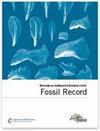下载PDF
{"title":"瑞典Siljan地区Hirnantian头足类动物的质量浓度分类学、古生态学和古生物地理关系","authors":"Björn Kröger, Jan Ove R. Ebbestad, Annette E. S. Högström, Åsa M. Frisk","doi":"10.1002/mmng.201000014","DOIUrl":null,"url":null,"abstract":"<p>The Hirnantian Glisstjärn Formation (<i>Normalograptus persculptus</i> graptolite Biozone) is a succession of limestones and shales onlapping the Katian Boda Limestone in the Siljan District, Sweden. It contains a conspicuous, up to several decimeter thick bed densely packed with bipolarly oriented, orthoconic cephalopod conchs that can reach lengths of more than 120 cm. Conch fragmentation, bioereosion and the generally poor preservation of the conchs indicate time averaging and the conchs are tentatively interpreted as beached, and a result of winnowing. Ten nautiloid species were collected from the Glisstjärn Formation of which five are new: <i>Dawsonoceras gregarium</i> n. sp., <i>Discoceras siljanense</i> n. sp., <i>Isorthoceras dalecarlense</i> n. sp., <i>Retizitteloceras rarum</i> gen. et sp. n., and <i>Transorthoceras osmundsbergense</i> gen. et sp. n. The non-endemic taxa in most cases are known from elsewhere in Baltoscandia, except one species which is known from Siberia, and North America respectively. Proteocerid orthoceridans dominate the association, of which <i>T. osmundsbergense</i> is the predominant species. Oncocerids are diverse but together with tarphycerids very rare. Notable is the lack of many higher taxa, that are typical for other Late Ordovician shallow water depositional settings. Based on the taxonomical composition of the cephalopod mass occurrence it is interpreted as an indicator of eutrophication of the water masses in the area. (© 2011 WILEY-VCH Verlag GmbH & Co. KGaA, Weinheim)</p>","PeriodicalId":55147,"journal":{"name":"Fossil Record","volume":null,"pages":null},"PeriodicalIF":1.4000,"publicationDate":"2011-02-22","publicationTypes":"Journal Article","fieldsOfStudy":null,"isOpenAccess":false,"openAccessPdf":"https://sci-hub-pdf.com/10.1002/mmng.201000014","citationCount":"11","resultStr":"{\"title\":\"Mass concentration of Hirnantian cephalopods from the Siljan District, Sweden; taxonomy, palaeoecology and palaeobiogeographic relationships\",\"authors\":\"Björn Kröger, Jan Ove R. Ebbestad, Annette E. S. Högström, Åsa M. Frisk\",\"doi\":\"10.1002/mmng.201000014\",\"DOIUrl\":null,\"url\":null,\"abstract\":\"<p>The Hirnantian Glisstjärn Formation (<i>Normalograptus persculptus</i> graptolite Biozone) is a succession of limestones and shales onlapping the Katian Boda Limestone in the Siljan District, Sweden. It contains a conspicuous, up to several decimeter thick bed densely packed with bipolarly oriented, orthoconic cephalopod conchs that can reach lengths of more than 120 cm. Conch fragmentation, bioereosion and the generally poor preservation of the conchs indicate time averaging and the conchs are tentatively interpreted as beached, and a result of winnowing. Ten nautiloid species were collected from the Glisstjärn Formation of which five are new: <i>Dawsonoceras gregarium</i> n. sp., <i>Discoceras siljanense</i> n. sp., <i>Isorthoceras dalecarlense</i> n. sp., <i>Retizitteloceras rarum</i> gen. et sp. n., and <i>Transorthoceras osmundsbergense</i> gen. et sp. n. The non-endemic taxa in most cases are known from elsewhere in Baltoscandia, except one species which is known from Siberia, and North America respectively. Proteocerid orthoceridans dominate the association, of which <i>T. osmundsbergense</i> is the predominant species. Oncocerids are diverse but together with tarphycerids very rare. Notable is the lack of many higher taxa, that are typical for other Late Ordovician shallow water depositional settings. Based on the taxonomical composition of the cephalopod mass occurrence it is interpreted as an indicator of eutrophication of the water masses in the area. (© 2011 WILEY-VCH Verlag GmbH & Co. KGaA, Weinheim)</p>\",\"PeriodicalId\":55147,\"journal\":{\"name\":\"Fossil Record\",\"volume\":null,\"pages\":null},\"PeriodicalIF\":1.4000,\"publicationDate\":\"2011-02-22\",\"publicationTypes\":\"Journal Article\",\"fieldsOfStudy\":null,\"isOpenAccess\":false,\"openAccessPdf\":\"https://sci-hub-pdf.com/10.1002/mmng.201000014\",\"citationCount\":\"11\",\"resultStr\":null,\"platform\":\"Semanticscholar\",\"paperid\":null,\"PeriodicalName\":\"Fossil Record\",\"FirstCategoryId\":\"89\",\"ListUrlMain\":\"https://onlinelibrary.wiley.com/doi/10.1002/mmng.201000014\",\"RegionNum\":4,\"RegionCategory\":\"地球科学\",\"ArticlePicture\":[],\"TitleCN\":null,\"AbstractTextCN\":null,\"PMCID\":null,\"EPubDate\":\"\",\"PubModel\":\"\",\"JCR\":\"Q3\",\"JCRName\":\"Earth and Planetary Sciences\",\"Score\":null,\"Total\":0}","platform":"Semanticscholar","paperid":null,"PeriodicalName":"Fossil Record","FirstCategoryId":"89","ListUrlMain":"https://onlinelibrary.wiley.com/doi/10.1002/mmng.201000014","RegionNum":4,"RegionCategory":"地球科学","ArticlePicture":[],"TitleCN":null,"AbstractTextCN":null,"PMCID":null,"EPubDate":"","PubModel":"","JCR":"Q3","JCRName":"Earth and Planetary Sciences","Score":null,"Total":0}
引用次数: 11
引用
批量引用


